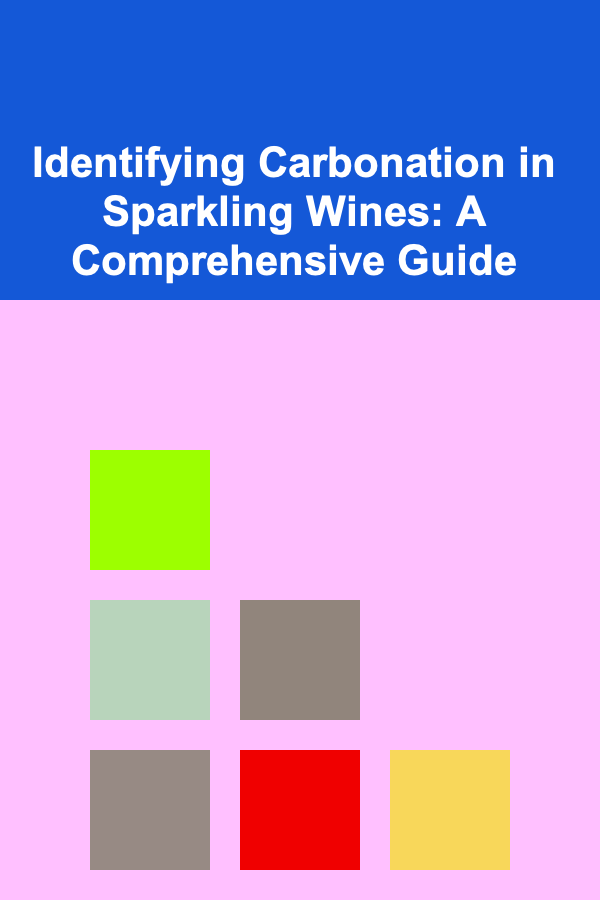
Identifying Carbonation in Sparkling Wines: A Comprehensive Guide
ebook include PDF & Audio bundle (Micro Guide)
$12.99$9.99
Limited Time Offer! Order within the next:

Sparkling wine, with its effervescent charm and celebratory aura, has captivated palates for centuries. Whether it's Champagne, Prosecco, Cava, or another of the myriad sparkling wines from around the globe, the defining characteristic that separates it from still wine is its carbonation -- the presence of dissolved carbon dioxide (CO2) manifested as bubbles. While simply observing the bubbles seems straightforward, a deeper understanding of the different methods of production, the various factors affecting carbonation levels, and subtle nuances in bubble appearance and behavior can significantly enhance your appreciation and enjoyment of these delightful beverages.
This comprehensive guide will delve into the science and art of identifying carbonation in sparkling wines, equipping you with the knowledge to assess not just the presence, but also the quality, stability, and overall impact of the bubbles on the wine's sensory profile.
Understanding Carbonation: The Fundamentals
At its core, carbonation in sparkling wine is the result of dissolved carbon dioxide. This gas, produced during fermentation, is trapped within the sealed bottle, leading to increased pressure. When the bottle is opened, this pressure is released, and the dissolved CO2 escapes in the form of bubbles.
- Production Method: The method used to create the sparkling wine directly impacts the level and type of carbonation. Traditional Method (Méthode Champenoise) wines, like Champagne, undergo a secondary fermentation in the bottle, creating a more integrated and refined carbonation. Charmat Method wines, like Prosecco, are carbonated in large tanks, typically resulting in larger, more exuberant bubbles. Transfer Method and other alternative methods also contribute to varying levels of carbonation.
- Fermentation Conditions: Temperature, yeast strain, and nutrient availability during fermentation all play a role in the amount of CO2 produced. Lower temperatures tend to produce more CO2, while specific yeast strains are known for their efficiency in generating it.
- Bottle Pressure: The pressure inside the bottle is a direct measure of the dissolved CO2. Champagne, for example, typically has a pressure of 5-6 atmospheres (ATM) at 20°C, while Prosecco often falls in the range of 3-4 ATM.
- Temperature: Temperature significantly affects the solubility of CO2 in wine. Colder temperatures allow more CO2 to dissolve, resulting in a more persistent and finer bubble structure. Serving sparkling wine at the appropriate temperature (typically between 6-10°C) is crucial for optimal carbonation and flavor expression.
- Wine Composition: The presence of certain compounds in the wine, such as proteins and polysaccharides, can influence the size and stability of the bubbles. These compounds act as surfactants, affecting the surface tension and influencing bubble formation.
Visual Indicators: Observing the Bubbles
The most immediate way to assess carbonation is through visual observation. Carefully examining the bubbles as the wine is poured and settles in the glass can reveal a wealth of information.
1. Bubble Size and Formation:
- Size: Smaller bubbles generally indicate a higher quality sparkling wine and a more integrated carbonation, often achieved through traditional methods. Larger bubbles, on the other hand, are often characteristic of Charmat method wines or wines that have lost some of their carbonation.
- Formation: Observe how the bubbles form. Ideally, they should emerge from nucleation points (imperfections in the glass) at a consistent and steady rate. A sudden burst of large bubbles might indicate a wine that is losing its carbonation quickly or was not properly carbonated in the first place.
- Persistence: How long do the bubbles last? A good sparkling wine will exhibit persistent bubbles that continue to rise to the surface for a significant period. Rapid dissipation suggests low carbonation or a fault in the wine.
2. Mousse and Bead:
- Mousse: The mousse refers to the frothy layer of bubbles that forms on the surface of the wine after pouring. A rich and creamy mousse is a desirable characteristic, indicating a well-integrated carbonation. A thin or quickly dissipating mousse suggests weak carbonation. The mousse should ideally be persistent and leave a lacy rim (collar) around the edge of the glass.
- Bead: The bead refers to the stream of bubbles rising from the bottom of the glass. A continuous and fine bead is a sign of good quality. Intermittent or coarse beads may indicate issues with carbonation. The speed of the bead, the fineness of the bubbles, and the duration for which the bead persists all are important indicators.
3. Glassware Considerations:
- Shape: The shape of the glass significantly impacts the perception of carbonation. Flutes, with their tall, narrow shape, concentrate the bubbles and direct them towards the nose, enhancing the aromatic experience. Coupes, while visually appealing, tend to allow the bubbles to dissipate more quickly. White wine glasses or tulip-shaped glasses, offer a good compromise allowing for aromatic expression and bubble retention.
- Cleanliness: A clean glass is essential for optimal bubble formation. Residue from detergents or other substances can interfere with the nucleation process and affect the appearance of the bubbles. Ensure the glass is thoroughly rinsed and dried before pouring the wine. Avoid using dish soap with added 'shine enhancers' as these can leave a residue on the glass, impacting the bead.
- Nucleation Points: Ideally, bubbles will rise from tiny imperfections or scratches on the inside of the glass, known as nucleation points. Some manufacturers intentionally etch small dots on the bottom of sparkling wine glasses to encourage bubble formation. If no bubbles are forming, gently scratch the inside of the glass with a clean, pointed object (like a butter knife) to create a nucleation point. However, exercise extreme caution to avoid breaking the glass.
Auditory Cues: Listening to the Fizz
While less precise than visual observation, the sound of the bubbles as they burst can provide clues about the carbonation level and bubble size.
- The Pop: The sound of the cork popping when the bottle is opened provides the first indication of pressure. A sharp, distinct pop suggests a well-carbonated wine, while a muffled or weak pop might indicate lower pressure.
- The Fizz: Listen carefully to the sound of the bubbles as they rise to the surface. A gentle, sustained fizz is characteristic of fine bubbles, while a louder, more aggressive fizz might indicate larger bubbles.
Tactile Sensations: Feeling the Bubbles
The tactile sensation of the bubbles on the palate is a crucial aspect of the sparkling wine experience. The perceived texture of the bubbles contributes significantly to the overall mouthfeel and enjoyment of the wine.
- Mouthfeel: Describe the texture of the bubbles. Are they fine and delicate, creating a creamy or silky sensation? Or are they coarse and aggressive, feeling prickly or sharp on the tongue? Fine, well-integrated bubbles are generally considered more desirable, contributing to a smoother and more elegant mouthfeel.
- Acidity: Carbonation enhances the perception of acidity. The tingling sensation of the bubbles can accentuate the wine's natural acidity, creating a refreshing and vibrant profile. Wines with low acidity may seem flat or lacking in character, even if they are adequately carbonated.
- Balance: The carbonation should be in balance with the other elements of the wine, such as sweetness, acidity, and fruit flavors. Excessive carbonation can overwhelm the other flavors, while insufficient carbonation can make the wine seem flat or dull.
Factors Affecting Carbonation Longevity
Even in well-made sparkling wines, carbonation can dissipate over time once the bottle is opened. Several factors contribute to this process:
- Temperature: As mentioned earlier, temperature plays a crucial role in carbonation retention. Warmer temperatures cause CO2 to escape from the wine more rapidly. Keep the opened bottle chilled to slow down the dissipation of bubbles.
- Exposure to Air: The greater the surface area of the wine exposed to air, the faster the CO2 will escape. Use a stopper designed for sparkling wine to minimize air exposure.
- Pouring Technique: Pouring the wine gently, down the side of the glass, minimizes agitation and helps to preserve the bubbles. Avoid pouring directly into the bottom of the glass, which can cause excessive foaming and rapid carbonation loss.
- Stopper Quality: Use a good quality sparkling wine stopper that creates a tight seal to prevent CO2 from escaping. Many inexpensive stoppers are ineffective.
Distinguishing Carbonation Methods and Their Impact
The method used to produce the sparkling wine profoundly impacts the carbonation characteristics. Understanding these methods can help you anticipate the type of bubbles you'll encounter.
1. Traditional Method (Méthode Champenoise):
This is the most highly regarded method, used for Champagne and many other premium sparkling wines. The wine undergoes a secondary fermentation in the bottle, where yeast consumes sugar and produces CO2. The dead yeast cells (lees) are then removed through a process called riddling and disgorgement. This process results in fine, persistent bubbles that are well-integrated into the wine's structure.
Carbonation Characteristics: Fine, persistent bubbles; creamy mousse; elegant mouthfeel; often toasty or brioche-like aromas due to lees aging.
2. Charmat Method (Tank Method):
This method is commonly used for Prosecco and other less expensive sparkling wines. The secondary fermentation takes place in large, pressurized tanks. The wine is then filtered and bottled under pressure. This method is quicker and more cost-effective than the traditional method, but it generally results in larger, more exuberant bubbles.
Carbonation Characteristics: Larger, more aggressive bubbles; less persistent mousse; often fruitier and fresher aromas; less complex flavors than traditional method wines.
3. Transfer Method:
This method combines elements of both the traditional and Charmat methods. The wine undergoes a secondary fermentation in the bottle, but instead of riddling and disgorgement, the contents of the bottles are emptied into a pressurized tank, filtered, and then rebottled. This avoids the labor-intensive riddling process. The carbonation qualities are generally closer to those of the traditional method, though some complexity might be lost in the transfer and filtration.
Carbonation Characteristics: Finer bubbles than Charmat, but potentially less complex than Traditional method. The bubble quality tends to be more consistent compared to bottle-fermented wines where subtle bottle variations can occur.
4. Ancestral Method (Méthode Ancestrale):
Considered the oldest method, this involves bottling the wine before primary fermentation is complete. Fermentation continues in the bottle, trapping the CO2. Wines made this way are often unfiltered, resulting in cloudy appearance and earthy aromas.
Carbonation Characteristics: Typically less predictable and often produces a gentler effervescence than other methods. Sediment is commonly present. The bubbles can be rustic and less refined.
5. Carbonation Injection:
The least complex (and generally least desirable) method, simply involves injecting CO2 into a still wine. The carbonation is usually quite coarse and dissipates very quickly. This method is typically used for inexpensive sparkling wines.
Carbonation Characteristics: Large, aggressive bubbles; very short-lived; often artificial or harsh mouthfeel.
Potential Faults Affecting Carbonation
Several issues can negatively impact the carbonation of sparkling wines, leading to a less enjoyable experience.
- Loss of Pressure: If the seal of the bottle is compromised, CO2 can escape, resulting in a loss of pressure and weak carbonation. This can be due to a faulty cork, improper storage, or damage to the bottle.
- Secondary Fermentation Issues: In traditional method wines, problems with the secondary fermentation can lead to insufficient carbonation. This can be caused by weak yeast, lack of nutrients, or improper temperature control.
- Refermentation: Unexpected refermentation in the bottle after bottling can lead to excessive carbonation and even cause the bottle to explode. This is often due to residual sugar and the presence of live yeast.
- Diacetyl: While not directly related to carbonation, diacetyl (a buttery aroma) can sometimes be produced during fermentation. In excess, it can mask the delicate flavors of the wine and create an unpleasant mouthfeel, even if the carbonation is otherwise good.
- Hydrogen Sulfide (H2S): The presence of hydrogen sulfide (H2S), which smells like rotten eggs, can be a sign of stressed yeast during fermentation and negatively affect the overall quality of the wine. Even if the carbonation is present, the off-putting aroma will detract from the experience.
Conclusion: Appreciating the Art of Carbonation
Identifying and appreciating carbonation in sparkling wines is a skill that develops with practice and careful observation. By understanding the underlying principles of carbonation, the different production methods, and the potential faults that can arise, you can elevate your appreciation of these complex and celebratory beverages. Pay attention to the visual cues, listen to the sounds, and feel the textures on your palate. Each sparkling wine has its own unique personality, and the carbonation is a key element in shaping that character. Cheers to the bubbles!
This guide is for informational purposes only and should not be considered professional wine tasting advice. Taste is subjective, and individual preferences may vary. Always drink responsibly.

Beyond Compliance: Strategic Insights for Effective Environmental Consulting
Read More
How to Build a Checklist for Improving Your Public Speaking Skills for Business Presentations
Read More
How to Create a Family Recipe Tradition
Read More
How to Create Hidden Storage in Small Apartments
Read More
How to Make Money Online as an Immunologist: 10 Actionable Ideas
Read More
How to Plan for a Seamless Home Renovation Experience
Read MoreOther Products

Beyond Compliance: Strategic Insights for Effective Environmental Consulting
Read More
How to Build a Checklist for Improving Your Public Speaking Skills for Business Presentations
Read More
How to Create a Family Recipe Tradition
Read More
How to Create Hidden Storage in Small Apartments
Read More
How to Make Money Online as an Immunologist: 10 Actionable Ideas
Read More